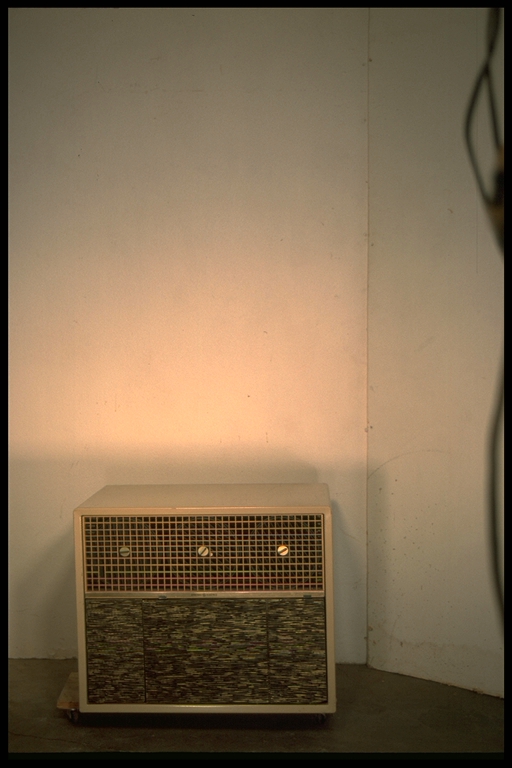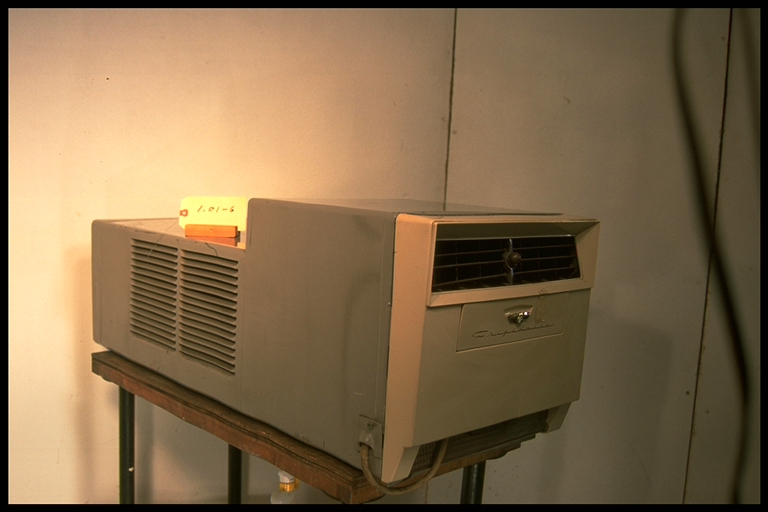1.02-2: GE 1959 Through-The-Wall, Room, Air Conditioner

| HHCC Accession No. 2003.007 | HHCC Classification Code: 1.02-2 |
|---|
Description:
Household, Through-the-Wall, Room, Air Conditioner, General Electric, 1959
Group:
1.02 Unitary Refrig. and A/C Equipment and Systems - Household Air Conditioners
Make:
General Electric
Manufacturer:
GE, Louisville USA
Model:
1R32NA
Serial No.:
SN2-01292
Size:
25x 16 1/2x 21’
Weight:
Circa:
1959
Rating:
Exhibit Quality, excellent example of the genre, new , fully operational equipment with original price tag
Patent Date/Number:
Provenance:
From York County (York Region) Ontario, once a rich agricultural hinterlands, attracting early settlement in the last years of the 18th century. Located on the north slopes of the Oak Ridges Moraine, within 20 miles of Toronto, the County would also attract early ex-urban development, to be come a wealthy market place for the emerging household and consumer technologies of the early and mid 20th century.
This artifact was discovered in the 1960’s in the stock of T. H. Oliver, Refrigeration and Electric Sales and Service, Aurora, Ontario, an early worker in the field of agricultural, industrial and consumer technology.
Type and Design:
A household, unitary, room air conditioner designed for through-the-wall, or through-the-window applications, in which the heat is rejected to the exterior of the home by means of a forced air condenser. The air conditioner operating system employs the compression refrigeration cycle operating on a theoretical Carnot cycle.
Construction:
Material:
Special Features:
Automatic temperature control, out-side air damper, air filter air freshning cartridge Unused equipment with original price tag and original owners manual
Accessories:
:
Capacities:
120Volts, 6.5 Amps, 60 cycle, 1/2 HP,
Performance Characteristics:
Operation:
Control and Regulation:
Automatic temperature control
Targeted Market Segment:
The household, summer air conditioning market developed through the 1960-70’s much more rapidly in southern Ontario than many anticipated helped by the buoyant economy of the post WWII years and the culture of social change and consumerism that was evident.
For many householders and small commercial applications, the through-the-wall room air conditioner was the next step, in adaptation to central, summer, comfort cooling. Many manufactures, such as GE made one model adaptable for both through-the-window and wall applications.
Consumer Acceptance:
Merchandising:
The market competition for room air conditioners was fierce, with a small select market to draw on manufacturers were looking to features to promote their products and increase market share, many of little real functional value to the owner. A throwaway capsule it was quickly exhausted. The air freshener capsule provided by GE was such a sales gimmick.
Market Price:
Original prise tag shows marked down price of $179.50, well below list prices for the period.
Technological Significance:
Unitary Refrigeration Equipment: The idea of a unitary piece of refrigeration or air conditioning equipment was a significant one in its own right, one that had to wait its time. The scientists, engineers and inventors in the early years of the 20th century were intrigued and obsessed with the power of the technology and of its possible market potential. What they saw was the newly discovered principles of physics and heat engines - following, for example, the early works of Carnot, Faraday, Kelvin, and the later work of Perkins, Larsen and Carrier, to name a few.
They understood the promise of the technology for the public good, not to say its consumer sales potential. Early engineering work advanced on a multiple fronts with development of compressors, heat exchangers, valves and piping variously strung together in configurations that would be found to work, but only after much experimentation.
The arrival of unitary equipment, all those parts organised into a single whole, a single unit of construction, a ‘black box’, that could be offered to the consumer market was a significant technological and cultural event. Technologically the refrigerator would need to be seen to be safe, reliable, maintainable and useful. As well, in order to attract the development capital needed, it must be seen as potentially saleable and affordable, contributing to life’s needs and desires. Its socio- cultural and economic significance was marked, for it would change much. As Canadians we would quickly come enjoy potentially healthier lives, expect new levels of comfort and convenience, with a broader, safer, more diverse and enjoyable diet.
As a result, Canadians would quickly come to think of their day differently, for the day would be defined and punctuated in different ways than ever before, as a result of the introduction of modern, electric, household appliances, of which refrigerators, freezers and room air conditioners would be a central part, by the mid 20th century
J. M Larsen produced a manually operated household refrigerator of sorts in 1913, but it was not until 1918 that the Kelvinator Company marketed the first automatic, unitary refrigerator for the home. In that year, it is reported to have sold sixty-seven machines. (See Note 1) The historic artifacts in Group 1.00, Unitary Equipment, including significant samplings the early work of Kelvinator of Canada, provide a rare view of the evolution of unitary refrigeration and air conditioning applications, as they evolved in Canada in the first half of the 20th century.
For those formative years, the artifacts in this Group, 1.00, are typical of the offerings of the Canadian refrigeration and air conditioning industry. They personified the applications found in the homes, farms and commercial premises of the period for, those that could afford life’s new amenities of comfort, convenience and privilege.
The Significance of this Specimen rests in its special transitional status as a “sandwich technology’, between the window, room air conditioner and central summer cooling for the Canadian home, which would soon follow for all those who could afford it.
Industrial Significance:
Beautifully engineered and crafted this machine stands as a model of the refrigeration engineering know-how of the period, as well as the sophisticated production engineering that industry giants, with massive economic resources, such as GE, could bring to the field.
Socio-economic Significance:
See Report 006
Socio-cultural Significance:
Donor:
G. Leslie Oliver, The T. H. Oliver HVACR Collection
